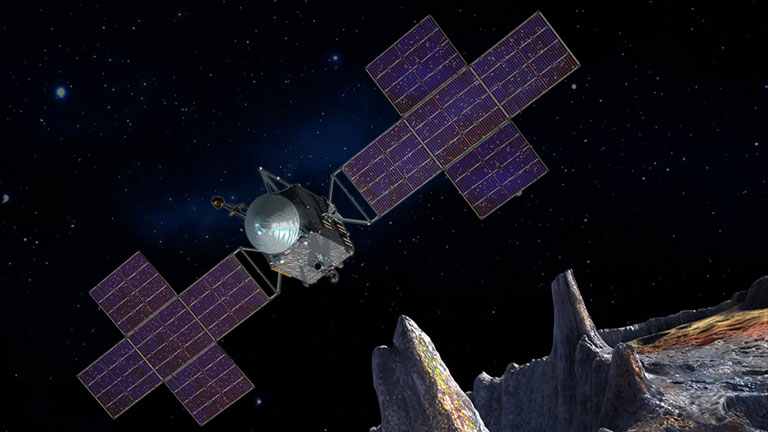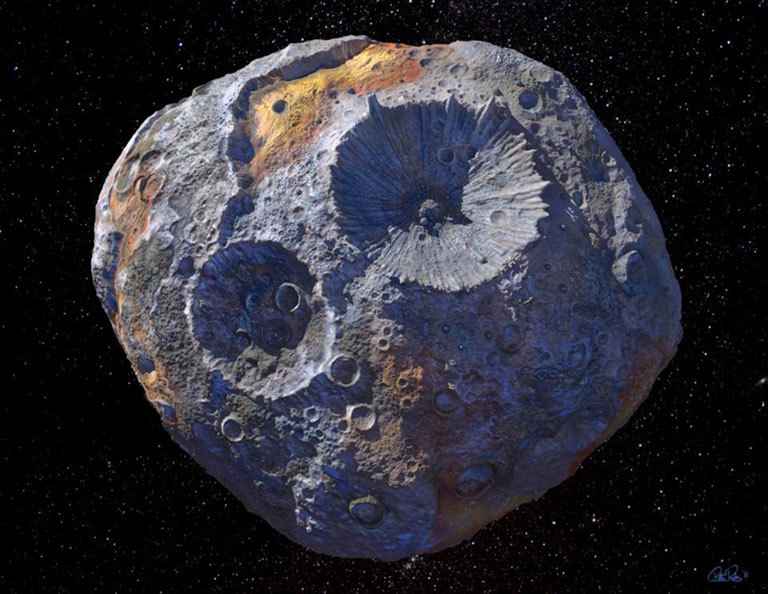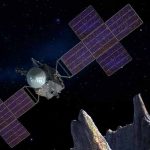NASA asked Elon Musk SpaceX to mine the giant gold asteroid (16 Psyche) that could make everyone on Earth a billionaire; worth $700,000 quadrillion dollars

In September, we wrote about the gold asteroid named 16 Psyche after NASA announced that it was working to uncover the mystery behind an asteroid that may contain a priceless treasure trove of minerals. The asteroid is estimated to be worth $700,000 quadrillion, an amount that could make everyone on Earth a billionaire.
NASA said it’s planning to send an unmanned spacecraft to the chunk of metal known as 16 Psyche. The mysterious object is loaded with heaps of platinum, iron, and nickel. The asteroid was named after the nymph Psyche, who married Cupid but was put to death by Venus. At Cupid’s request, however, Jupiter made Psyche immortal.
NASA wanted Elon Musk’s rocket company SpaceX to assist in a future space exploration mission of a giant metallic asteroid. Early this year, NASA awarded SpaceX a $117 million contract to launch the Psyche spacecraft, and two smallsat secondary missions, on a Falcon Heavy rocket in July 2022 on a Falcon Heavy rocket from Launch Complex 39A at Cape Canaveral Air Force Station in Florida. Psyche 16 is nestled between the orbits of Mars and Jupiter and is made of solid metal. That means if we carried it back to Earth, it would destroy commodity prices and cause the world’s economy – worth $75.5 trillion – to collapse.
The Psyche mission will journey to a unique metal-rich asteroid, also named Psyche, which orbits the Sun between Mars and Jupiter. The asteroid is considered unique, as it appears to largely be made of the exposed nickel-iron core of an early planet – one of the building blocks of our solar system.
Now, a new study published by Southwest Research Institute planetary scientist Dr. Tracy Becker further confirms why NASA wanted SpaceX to mine the space rock that’s more than 230 million miles from Earth. The reason: The 16 Psyche asteroid is entirely comprised of iron and nickel that some scientists estimate could be worth $700,000 quadrillion dollars.
Using the Space Telescope Imaging Spectrograph on the Hubble Space Telescope during two separate observations, scientists observed the 16 Psyche asteroid at ultraviolet (UV) wavelengths (170–310 nm). The 16 Psyche is one of the most massive objects in the asteroid belt orbiting between Mars and Jupiter. It measures 140 miles across, and in previous observations, it has been shown as a dense metallic core of a failed plant.
The mission to 16 Psyche was originally targeted to launch in October 2023, with an Earth gravity assist maneuver in 2024, a Mars flyby in 2025, and arriving at the asteroid in 2030. In May 2017 the launch date was moved up to target a more efficient trajectory, launching in 2022, with a Mars gravity assist in 2023 and arriving in 2026.
NASA said the Psyche mission will test a sophisticated new laser communication technology that encodes data in photons (rather than radio waves) to communicate between a probe in deep space and Earth. Using light instead of the radio allows the spacecraft to communicate more data in a given amount of time. The DSOC team is based at the Jet Propulsion Laboratory.

Artist’s concept of the asteroid 16 Psyche, which is thought to be a stripped planetary core. Image credit: Maxar/ASU/P. Rubin/NASA/JPL-Caltech
According to NASA, one of the most intriguing targets in the main asteroid belt, 16 Psyche is a giant metal asteroid, about three times farther away from the sun than is the Earth. Its average diameter is about 140 miles (226 kilometers) — about one-sixteenth of the diameter of Earth’s Moon or about the distance between Los Angeles and San Diego. Unlike most other asteroids that are rocky or icy bodies, scientists think the M-type (metallic) asteroid 16 Psyche is comprised mostly of metallic iron and nickel similar to Earth’s core. Scientists wonder whether Psyche could be an exposed core of an early planet, maybe as large as Mars, that lost its rocky outer layers due to a number of violent collisions billions of years ago.
Astronomers on Earth have studied 16 Psyche in visible and infrared wavelengths, as well as radar, which suggests Psyche is shaped somewhat like a potato. Observations indicate that its dimensions are 173 miles by 144 miles, by 117 miles (that’s 279, 232, and 189 kilometers, respectively). Psyche orbits the Sun between the orbits of Mars and Jupiter at a distance ranging from 235 million to 309 million miles (378 million to 497 million kilometers) from the Sun. That’s 2.5 to 3.3 Astronomical Units (AU), with 1 AU being the distance between Earth and the Sun. Psyche takes about five Earth years to complete one orbit of the Sun, but only a bit over four hours to rotate once on its axis (a Psyche “day”).
Here is another video.




